The Pula Amphitheatre stands tall as a testament to ancient Roman engineering and the captivating world of gladiatorial combat. This iconic structure, capable of seating up to 23,000 spectators, was the stage for thrilling displays of strength, skill, and often, grim fates. Within its walls, slaves and prisoners-turned-warriors underwent intense training, honing their abilities to entertain the masses. But what was the true cost of this spectacle, and how did it shape the lives of those who fought for their survival? Explore the captivating world of the Pula Amphitheatre and the gladiators who left an indelible mark on ancient Roman society.
Key Points
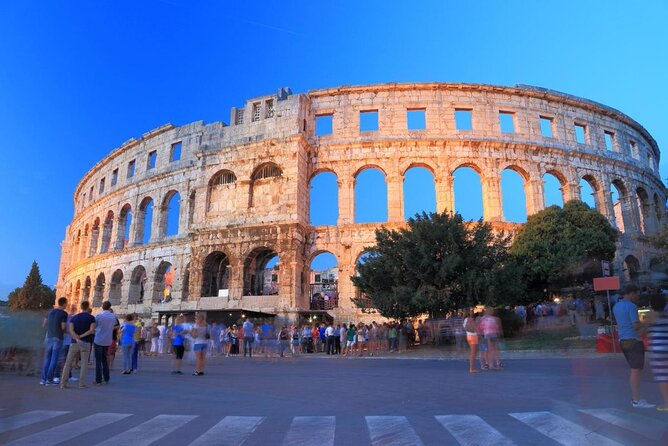
-
The Pula Amphitheatre, a well-preserved Roman arena, exemplifies ancient Roman architectural prowess and served as a venue for captivating gladiatorial contests.
-
Gladiators underwent rigorous training regimes, maintained strict diets, and cultivated a lifestyle characterized by discipline, determination, and pride in their combat skills.
-
Spectators from all social classes were drawn to the thrilling spectacles at the Pula Arena, with seating divided based on social status and active audience participation influencing fight outcomes.
-
The Pula Amphitheatre’s elliptical design and towering arched entrances create an impressive and immersive setting that transports visitors back to the grandeur of ancient Roman culture.
-
The Pula Amphitheatre’s designation as a UNESCO World Heritage Site underscores its significance as a testament to the cultural prowess and enduring influence of the Roman Empire.
Location and Architecture of Pula Amphitheatre

Situated in the picturesque coastal city of Pula, Croatia, the Pula Amphitheatre stands as a testament to the grandeur of ancient Roman architecture.
Constructed in the 1st century AD, this well-preserved arena was once the site of thrilling gladiatorial battles and public spectacles. Measuring 132 meters in length and 105 meters in width, the amphitheatre’s impressive size could accommodate up to 23,000 spectators.
With its distinctive elliptical shape and towering arched entrances, the Pula Amphitheatre is a true architectural masterpiece that continues to captivate visitors from around the world.
Its strategic location, overlooking the sparkling Adriatic Sea, only adds to the amphitheatre’s breathtaking allure.
You can also read our reviews of more tours and experiences in Pula.
Significance of the Pula Amphitheatre
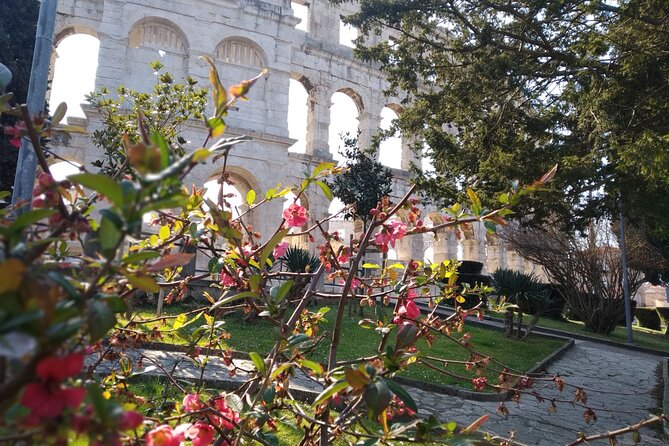
The Pula Amphitheatre holds immense significance as a testament to the grandeur and cultural prowess of ancient Rome. This magnificent structure, dating back to the 1st century AD, served as a hub for thrilling gladiatorial contests and public spectacles that captivated audiences for centuries. Its sheer size, intricate architectural design, and enduring legacy make it a true marvel of the ancient world.
| Seating Capacity | Over 20,000 |
|---|---|
| Notable Events | Gladiator Fights, Animal Hunts, Public Executions |
| Current Status | UNESCO World Heritage Site, Major Tourist Attraction |
| Symbolism | Power, Might, and Cultural Sophistication of Rome |
The Pula Amphitheatre remains a powerful symbol of Rome’s enduring influence and a must-visit destination for anyone exploring the rich history and cultural heritage of this remarkable civilization.
Gladiator Fights at the Pula Arena
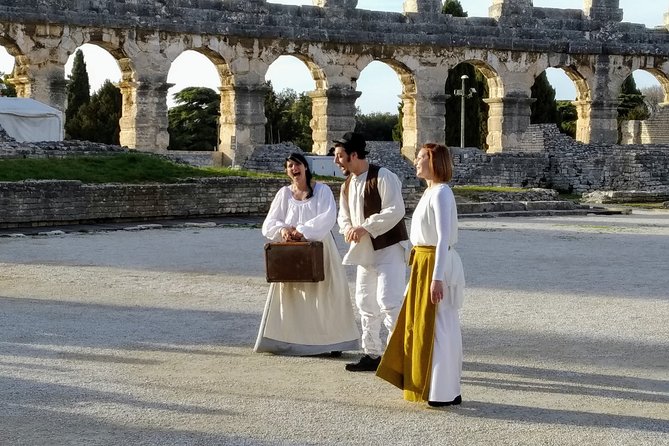
At the Pula Arena, spectators from across the ancient Roman Empire were captivated by the thrilling gladiatorial contests that took place within its massive, elliptical walls.
These brutal battles featured skilled fighters known as gladiators, who risked their lives for the entertainment of the crowd. Typically held during the summer months, the gladiator fights were a separate event from the guided tours of the amphitheatre itself.
Visitors interested in witnessing these spectacles would need to purchase additional tickets and attend the evening performances. While the guided tours provide a glimpse into the amphitheatre’s history, the gladiator fights allowed visitors to experience the true intensity and drama of life in the Roman era.
Gladiator Training and Lifestyle
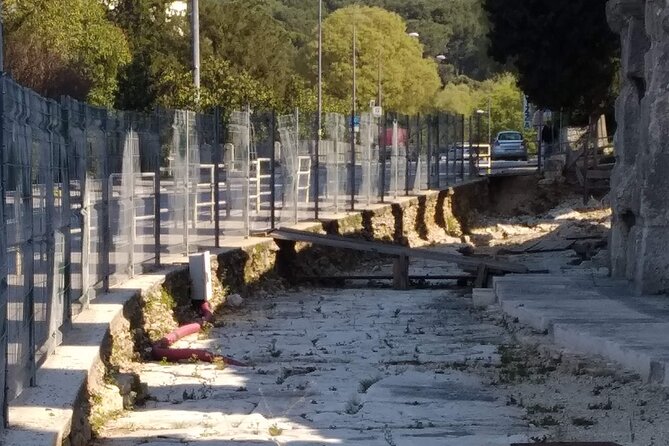
Aspiring gladiators underwent rigorous training regimes to hone their skills and physical prowess. They’d start their day at dawn, training with weapons and practicing combat techniques for hours on end.
Proper nutrition and conditioning were paramount – gladiators followed strict diets to maintain their muscular physique.
When not training, they’d often relax in the ludus, a gladiator school, socializing and bonding with their fellow fighters.
The gladiator lifestyle was harsh, but these men took immense pride in their craft, driven by the prospect of fame, fortune, and the roar of the crowd.
Surviving the rigors of this profession was no easy feat, requiring unwavering discipline, determination, and sheer force of will.
Spectators and Audience Experiences
Drawn by the prospect of thrilling spectacles, spectators flocked to the Pula Amphitheatre in ancient Roman times, eager to witness the captivating displays of skill and valor.
The atmosphere was electric as audiences eagerly awaited the start of the events.
Some key aspects of the spectator experience:
-
Social Stratification: Seating was divided based on social class, with the most prestigious spots reserved for the elite.
-
Audience Participation: Spectators actively engaged, cheering, jeering, and even influencing the outcome of the fights.
-
Rituals and Customs: Spectators followed various rituals and traditions, such as making offerings or wearing specific attire.
-
Entertainment Beyond Fights: Between matches, spectators enjoyed other forms of entertainment, from music to theatrical performances.
Pula Amphitheatre’s Role in Ancient Roman Society
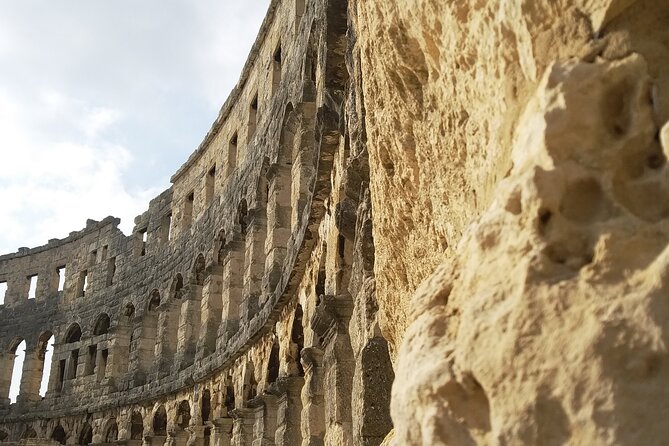
The Pula Amphitheatre played a pivotal role in ancient Roman society, serving as a hub for entertainment, cultural exchange, and social stratification.
As one of the largest and best-preserved Roman arenas, it hosted a variety of spectacles that captivated audiences, from gladiatorial contests to theatrical performances.
The amphitheatre’s grand design and central location underscored its significance, reflecting the Roman Empire’s power and influence.
Attendance at these events was a mark of social status, with seating arrangements reinforcing the rigid hierarchy of Roman society.
Beyond mere entertainment, the Pula Amphitheatre fostered cultural sharing and exposed spectators to the diverse customs and traditions of the Roman world.
Visiting the Pula Amphitheatre Today
Today, visitors to Pula, Croatia can explore the grandeur of the Pula Amphitheatre, a remarkably well-preserved Roman arena that offers a glimpse into the captivating world of ancient Roman entertainment.
The amphitheatre’s impressive opening hours allow visitors to tour the site at their convenience, with the exception of Wednesdays and Sundays when it’s open for a shorter period.
Key features of the Pula Amphitheatre experience include:
- Professional guides to provide insightful commentary
- Wheelchair and stroller accessibility for all visitors
- Proximity to public transportation for easy access
- Opportunity to witness evening gladiatorial fights (additional cost)
Though the guided tours don’t include the famous gladiator fights, these can be enjoyed separately for an additional fee, allowing visitors to fully enjoy the captivating history of this ancient Roman landmark.
Since You Asked
How Can I Purchase Tickets for the Evening Gladiator Fights?
To purchase tickets for the evening gladiator fights at the Pula Amphitheatre, you’ll need to contact the local provider directly. They’ll be able to provide details on availability, pricing, and how to secure your seats for the exciting event.
Are Photography and Filming Allowed During the Guided Tour?
Photography and filming are generally allowed during the guided tour of the Pula Amphitheatre. Visitors should check with the tour provider for any specific restrictions or limitations before the tour begins.
Can I Bring My Own Food and Drinks Into the Amphitheatre?
You can bring your own food and drinks into the Pula Amphitheatre, but be mindful of any rules or restrictions the tour provider may have. It’s best to check with them in advance to ensure a smooth and enjoyable visit.
What Is the Dress Code for Visiting the Pula Amphitheatre?
The Pula Amphitheatre doesn’t have a strict dress code, but visitors should wear comfortable, weather-appropriate clothing. Casual attire is fine, though you may want to avoid overly revealing outfits as the site is a historic and cultural destination.
Are There Any Special Accommodations for Visitors With Disabilities?
The Pula Amphitheatre tour is wheelchair and stroller accessible. Visitors with service animals are also welcome. Located near public transportation, the tour provides accommodations to ensure a comfortable experience for all travelers.
The Sum Up
The Pula Amphitheatre stands as a remarkable testament to the architectural prowess and cultural influence of ancient Rome. Its grand structure once hosted thrilling gladiatorial contests, captivating audiences eager for the spectacle. Today, visitors can explore this iconic venue, seeing the rich history of the Roman Empire and the captivating world of the gladiators who fought for their lives within its walls.
More Tour Reviews in Pula
- Pula: Sunset/Night Illuminated Transparent Kayak Tour
- Pula: Sea Adventure Boat, Kayak, Snorkeling & Cliff Jumps
- Pula: Brijuni Dolphin Watching cruise with Dinner & Sunset
- Faana: Dolphin & Sunset
- Pula: Muzil Canyon Kayak Tour, Snorkeling and Cliff Jumping
- NP Brijuni Island Swimming & Dolphin Watching Sunset Cruise
Not for you? Here's more nearby things to do in Pula we have reviewed
- Pula: Sunset/Night Illuminated Transparent Kayak Tour
- Pula: Sea Adventure Boat, Kayak, Snorkeling & Cliff Jumps
- Pula: Brijuni Dolphin Watching cruise with Dinner & Sunset
- Faana: Dolphin & Sunset
- Pula: Muzil Canyon Kayak Tour, Snorkeling and Cliff Jumping
- NP Brijuni Island Swimming & Dolphin Watching Sunset Cruise
- Pula: Brijuni National Park Cruise, Lunch and Beach Escape
- Pula: E Foil Sunset Experience
- Pula Pub Crawl
- Pula: Cave, Canyon and Island Kayak Tour Snorkel&Explore
- FAZANA Koralj Boat Tour Galebove stijene-NP Brijuni
- Croatia, Istria: 7-Day Premium Cycling & Gourmet E-Bike Tour
